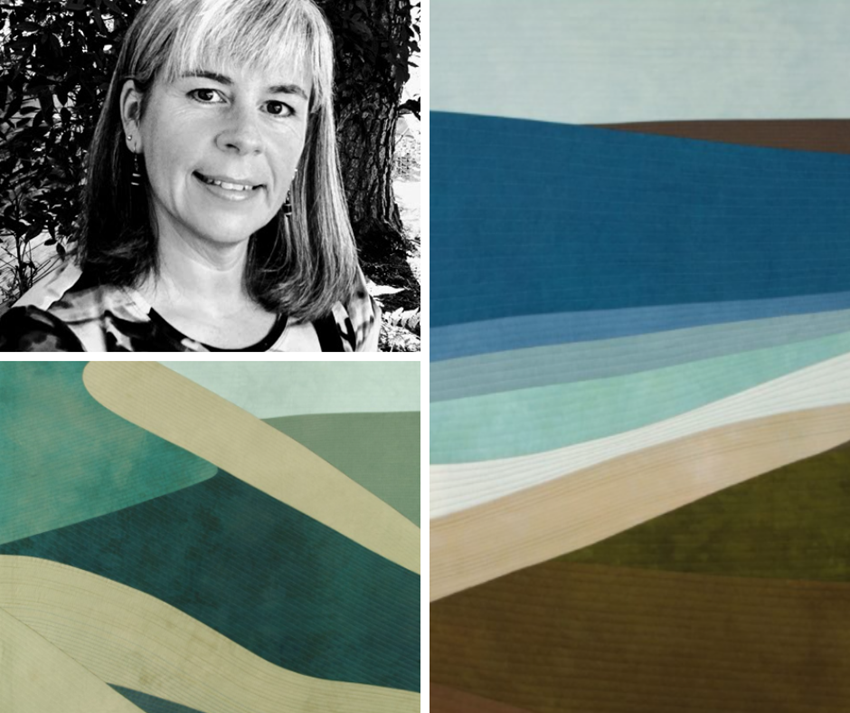A Conversation with OpenAIR MT Artist-in-Residence Lisa Flowers Ross
Recently, OpenAIR MT sat down with FLBS 2020 Fall Artist-in-Residence Lisa Flowers Ross to discuss her work.
How would you describe your work?
Flowers Ross: The majority of my artwork is abstract, with a focus on color and shapes and inspired by nature. My definition of abstract is a simplification of an object, view, form, idea or concept, as opposed to non-objective art or abstract expressionism.
In my observations of nature and daily surroundings, I am trying to find the simple essence of something and/or zooming in on details for a different perspective. I do not want to improve on nature or represent it realistically, but try to portray its simple beauty, find its underlying elements and present it in a unique way.
My main medium right now is fabric. But I occasionally work in printmaking and mixed media collage. For me, I find working with the different media uses different parts of the brain to process and different ways on how to approach creating an artwork.
What drew you to the Open AIR Artist-in-Residence program?
Flowers Ross: The locations of the Open AIR program were mostly what drew me to apply. I gather inspiration for my art and soul in nature. Being surrounded by beautiful natural environments excites me and also provides a calm quiet place in which to focus and get to work. I am constantly looking at the macroscopic and microscopic views of the plants, landscape, sky, birds, rocks, etc.
The residency at Flathead Lake Biological Station provides a great opportunity to learn more about the science behind nature and view nature through a different lens. I hope this will influence my art in some way and that I can incorporate some of the science into my pieces.
What are you most looking forward to (with the Residency)?
Flowers Ross: Being in a remote beautiful natural location next to Flathead Lake is what I was most looking forward to. Also, the unique opportunity to interact with the scientists here and learn more about what they are doing. An added bonus is the opportunity to kayak on the lake. Getting onto the lake provides a more active way to interact with the location and give me some different perspectives as I get away from the shoreline.
How do you anticipate connecting with a place-based residency?
Flowers Ross: During this residency, and my previous ones, I like to let the location inspire the direction of the work. Therefore, I come with some materials and fabrics, but don’t have an absolute plan of what I am going to make. I explore and look and wait for an idea to come. It usually does not take very long. It is important for me to get outside and be in nature as that informs the work. Some of the work I do here will become part of my Field Studies series, which is currently inspired by locations in the western states.
Since I cannot bring all of my studio with me, when I have an idea but not the materials to execute it, being in a remote location forces me to come up with another solution on how to realize a piece. It forces new avenues I might not explore at home.
Tell us about your most recent solo exhibition?
Lisa Flowers Ross: My most recent solo exhibition was this past March, just when the pandemic was starting to shut things down. The exhibition, Field Studies: Interpreting the West, was being shown at the Boise State University Student Union Gallery for the month. It was open for two weeks, but then BSU closed all the buildings to the public. The exhibition was cut short.
The Field Studies exhibition consists of a series of artworks made with my hand-dyed fabrics that have been pieced together to create vibrant images of places I have visited in the western states, using varying degrees of abstraction. From warm orange, red and burgundy colors inspired by Zion National Park to soothing blues depicting the coastal waters of California, the colors set the scene. Added stitching creates texture and depth that juxtaposes the strong flat color and shapes, as well as enhances the tactile nature of the piece.
The first showing of Field Studies was in a solo exhibition in Reno, Nevada. The concept for that was that all the pieces were inspired by locations in Nevada or one of the five states touching Nevada. For the Boise exhibition, Wyoming was added to the list. And now, I will be able to create art for the series inspired by Montana. I plan to continue working in the series and expanding to all the Western States.
How do you think about/use color in your work?
Flowers Ross: Color is a very important part of my work. My fabric pieces start with a tightly woven white fabric. I hand-dye all my own fabrics using only red, yellow and blue dyes to mix all my colors. The dyeing is an involved, time-consuming process that I usually only do once a year, outside during the summer. Although I aim to get a fairly flat solid color, there are subtle variations in the fabric that gives it a more organic, hand-dyed feel.
When I start an artwork, I am thinking of colors and values. I look through my fabric collection and start pulling out colors and seeing how they look together. If I don’t have a color I would like, I can’t just go dye it. So, I might have to use something else and adjust the other colors accordingly. Most often, I tend to use an analogous color scheme with bright saturated colors.


